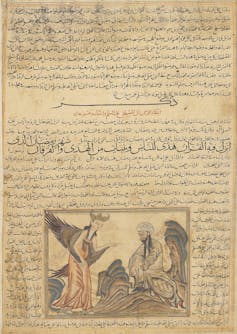By Christiane Gruber, University of Michigan | –
Hamline University in St. Paul, Minnesota, recently dismissed Erika López Prater, an adjunct faculty member, for showing two historical Islamic paintings of the Prophet Muhammad in her global survey of art history. Following complaints from some Muslim students, university administrators described such images as disrespectful and Islamophobic.
While many Muslims today believe it is inappropriate to depict Muhammad, it was not always so in the past. Moreover, debates about this subject within the Muslim community are ongoing. Within the academic world, this material is taught in a neutral and analytical way to help students – including those who embrace the Islamic faith – assess and understand historical evidence.

A painting showing the Prophet Muhammad raising his hands in prayer while standing on the Mountain of Light in Mecca, Siyer-i Nebi (Biography of the Prophet), Istanbul, Ottoman lands, 1595-96. Topkapı Palace Library, Istanbul, H. 1222, fol. 158v. Photograph by Hadiye Cangökçe.
As an expert on Islamic representations of the Prophet Muhammad, I consider the recent labeling of such paintings as “hate speech” and “blasphemy” not only inaccurate but inflammatory. Such condemnations can pose a threat to individuals and works of art.
The Prophet Muhammad has been represented in Islamic paintings since the 13th century. Islamic art historians such as my colleagues and me, both Muslim and non-Muslim, study and teach these images regularly. They form part of the standard survey of Islamic art, which includes calligraphy, ornament and architecture.
Comparing prophetic images
The 14th- and 16th-century images López Prater selected depict Muhammad receiving the beginning of Quranic revelations from God through the angel Gabriel. In Islamic thought, it is at that moment that Muhammad became a divinely appointed prophet.

Rashid al-Din, Jami‘ al-Tawarikh (Compendium of Chronicles), Tabriz, Iran, 1306-1315 CE. Edinburgh University Library, Edinburgh, Ms. Or. 20.
The 14th-century painting is part of a royal manuscript, the “Compendium of Chronicles,” written by Rashid al-Din. It is one of the earliest illustrated histories of the world. The manuscript includes numerous paintings, including a cycle of images depicting several key moments in the Prophet Muhammad’s life.
The one that was discussed in López Prater’s class appears in a section on the beginnings of Quranic revelation and Muhammad’s apostleship. The painting depicts the prophet with his facial features visible as the angel Gabriel approaches him to convey God’s divine word. The event is shown taking place outdoors in a rocky setting that matches the accompanying text’s description.
The second image, made in Ottoman lands in 1595-96, is part of a six-volume biography of the prophet. Over 800 paintings in this manuscript depict major moments in Muhammad’s life, from his birth to his death.

Al-Darir, Siyer-i Nebi (Biography of the Prophet), Istanbul, Ottoman lands, 1595-96. Topkapı Palace Library, Istanbul, H. 1222, fol. 158v. Photograph by Hadiye Cangökçe.
In that painting, Muhammad is seen raising his hands in prayer while standing on the Mountain of Light, known as Jabal al-Nur, near Mecca. His facial features are no longer visible; instead, they are hidden behind a facial veil.
The Ottoman artist chose to depict the prophet’s purity through the use of white fabrics, and his entire being as touched by the light of God via the large flaming nimbus that encircles his body. Jabal al-Nur is shown, as its name suggests, as a radiant elevation. Above it and beyond the clouds, rows of angels hover in praise.
Key study questions
These two paintings show that Islamic representations of Muhammad are neither static nor uniform. Rather, they evolved over the centuries. During the 14th century, artists depicted the prophet’s facial features, while later artists covered his face with a veil.
Islamic art historians ask their students to compare these two paintings while encouraging them to slow down, look carefully, train their eyes to detect pictorial elements, and infer meaning. They also ask students to consider the textual content and historical context accompanying the paintings.
The key question students are prompted to think about through the juxtaposition of these two Islamic paintings is this: Why did the facial veil and flaming nimbus develop as two key prophetic motifs in Islamic depictions of Muhammad between A.D. 1400 and 1600?
The images help a teacher guide a collective conversation that explores how the prophet was conceptualized in more metaphorical ways – as a veiled beauty and as radiant light – over the course of those two centuries in particular.
This prompts a larger exploration of the diversity of Islamic religious expressions, including those that are more Sufi, or spiritualized, in nature. These paintings therefore capture the richly textured mosaic of Muslim worlds over time.
This historically sensitive, pictorial side-by-side is known as a comparative analysis or “comparandum.” It is a key analytical method in art history, and it was used by López Prater in her classroom. Now more than ever, a rigorous study of such Islamic paintings proves necessary – and indeed vital – at a time of sharp debates over what is, or is not, Islamic.![]()
Christiane Gruber, Professor of Islamic Art, University of Michigan
This article is republished from The Conversation under a Creative Commons license. Read the original article.


 © 2025 All Rights Reserved
© 2025 All Rights Reserved